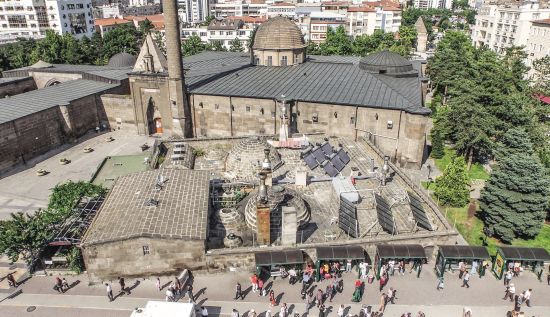MAHPERİ HATUN HAMMAM
Turkiye KAYSERİ 13th Century
HUAND / HUNADOlarak da bilinir.
1238
The hammam is located to the west of the Hunad Mosque in the Melikgazi district of Kayseri. It is a double hammam extending in the southeast-northwest direction; the northeast wing served the men while the smaller southwest wing served the ladies.
The main entrance to the men’s section is at the north end of the west façade and it is accessed via stairs leading down from the present-day street level. The changing hall has been refurnished with a concrete superstructure recently and a doorway in its south wall leads into the cold hall. Currently the changing hall does not serve its original function and the doorways leading into the hot and intermediary halls have been cancelled and a new changing hall has been formed. A doorway shifted westward in the south wall of the changing hall leads into the intermediary hall, which is covered with an oval dome supported with a vault on either side. A doorway in the middle of its south wall opens into the hot hall. The centre of the cruciform hot hall and the private bathing cells in the corners are covered with a dome whereas the iwans are covered with pointed barrel vaults.
The water tank of the hammam extends along the hot halls of both the men’s and women’s sections and is covered with a barrel vault. The stokehole has lost its original form.
The structure was built with dressed stones and the domes and transition systems with bricks; the interior is plastered over. The hammam has lost its original form to a great extent due to repairs through its history; however, it is intact and still serving the people.
In the course of the work in 1969, some in situ tiles were uncovered under the plaster of the cold hall and the northeast private bathing cell of the women’s section. In the men’s section, traces of tile pavement were noted on mortar of the walls of the southwest private bathing cell as well as fragments of monochrome glazed tiles were uncovered in the debris. These cruciform and star shaped tile fragments are decorated with human, animal and fantastic creature figures as well as stylised floral motifs and inscriptions; they are parallel to the palace tiles of the Seljuk period. The examples with underglaze technique are decorated in a limited range of colours as cobalt blue, eggplant purple and green on light background, and then glazed. Extant traces in the women’s section indicate tile pavement on the lower parts of the walls and flooring, and painted-stencilled as well as malakari (trowel-work) decoration on the upper parts of the walls.
In the absence of an inscription, evidence obtained in the course of excavations showed that the women’s and men’s sections were built at different times. Thus, it is thought that the men’s hammam was built before the Hunad Mosque of 1238 it adjoins, together with the madrasa of 1235 whereas the women’s section was built together with the mosque in 1238 by Mahperi (Huand/Hunad) Hatun.

